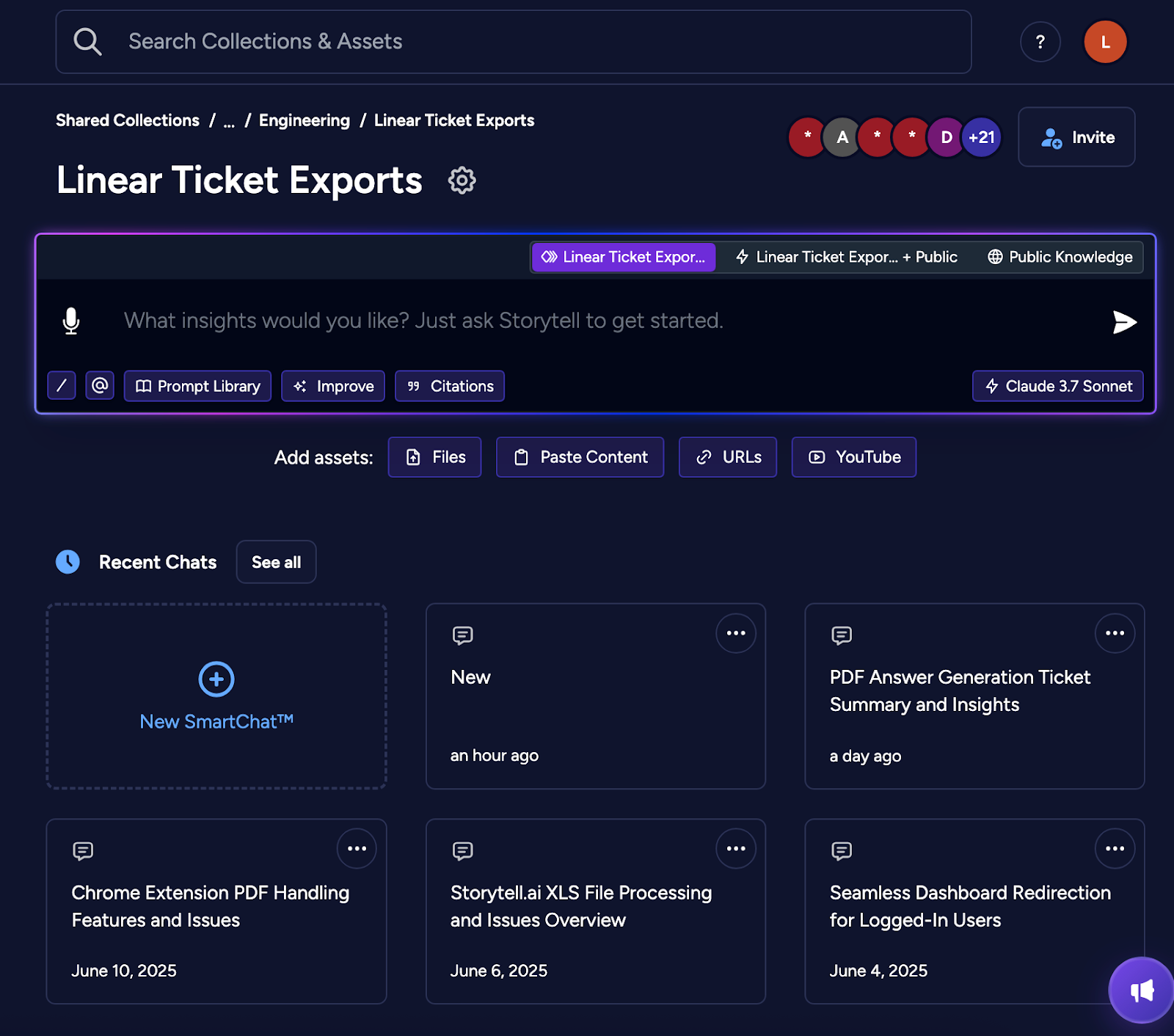Share this post
How Our Operations Assistant Turns Ticket Chaos into Organized Clarity in Minutes
June 17, 2025

As part of our series, where we showcase how different Crew members harness our platform to build a better product for you, our Operations Assistant, Lex, shares how he uses Storytell to search and organize Linear tickets—making it easier to track requests, avoid duplicates, and prioritize what matters.
Ever been asked about a feature request only to spend an hour digging through your project management system trying to remember if it already exists? Lex, our Operations Assistant, faced this challenge daily until he developed a simple workflow that turned a time-consuming task into a two-minute solution.
The Linear ticket challenge everyone faces
As our product evolves, tickets pile up in Linear – feature requests, bug reports, and enhancements. When teammates or users mention an idea, Lex needs to quickly determine the following:
- Have we already logged it?
- Is it in progress?
- Has someone else requested it too?
Without a good system, this becomes a tedious manual search through hundreds of tickets, eating up valuable time that could be spent on more impactful work.
What makes this particularly challenging is the variety of ways people describe the same feature. One person might ask for "PDF exports" while another requests "downloading answers as documents" – same need, different words. This is where Lex's Storytell workflow shines.
Lex's simple four-step workflow for ticket management
Step 1: Export the latest Linear board
Lex starts in Linear, where he filters for every ticket on the Engineering Board and exports the results as a CSV file. This export captures all the essential data – ticket IDs, titles, descriptions, labels, assignees, and current status.
Before uploading, he quickly cleans up the data like updating ticket numbers and organizing the tabs to make sure everything is current.
Step 2: Upload to a dedicated Storytell Collection
Next, Lex uploads the CSV to a dedicated "Linear Ticket Exports" Collection in Storytell. This Collection becomes a searchable repository of all engineering tickets.

By keeping all exports in one place, Lex builds a growing knowledge base that Storytell can search across, without cluttering his personal workspace or requiring complex database setups.
Step 3: Query in natural language
Here's where the magic happens. When someone mentions a feature or bug, Lex opens SmartChat™ and asks about it in plain English:
No SQL queries, no complex search syntax – just a straightforward question as if asking a colleague. Storytell searches through all the CSV data and returns relevant ticket information, including IDs and titles.
Step 4: Verify and tag the tickets
With Storytell's results in hand, Lex can now check the specific tickets in Linear to confirm they match the request. Once Lex confirms that a ticket already exists, he updates the ticket—tagging the person who made the request or adding a label that indicates multiple users have asked for the same thing. This step helps track interest in specific features and avoids unnecessary duplicates.
This final step closes the loop, ensuring nothing gets lost and that we track exactly how many users want each feature – crucial information for prioritizing our roadmap.
Why this approach matters (and how you can adopt it)
Lex's workflow transforms what could be a half-hour search job into a two-minute conversation with Storytell. But the benefits go beyond time savings:
- No duplicate tickets: We catch potential duplicates before creating them, keeping our engineering board clean
- Better prioritization: By tagging tickets with each requester, we see which features are most requested
- Historical tracking: As tickets evolve, older exports remain searchable, creating a timeline of work
- Accessible information: Anyone can run these searches, not just those familiar with Linear's advanced search syntax
Want to try this approach with your own project management system? Here's how:
- Export regularly: Set up recurring exports from your ticketing system (Jira, Linear, Asana, etc.)
- Create a Collection: Make a dedicated space in Storytell for these exports
- Ask naturally: Frame your searches as conversations, mentioning specific features or bugs. Try it here.
- Close the loop: Update your tickets based on what you learn
The beauty of this system is its simplicity and adaptability. You don't need to build complex integrations or learn new query languages – just export, upload, and ask.
Results we're seeing
Since implementing this system, Lex has dramatically reduced the time spent searching for existing tickets while improving our ability to track feature popularity. Engineers waste less time on duplicate tickets, and users get faster responses about whether their request is already in our pipeline.
This approach works whether you're managing dozens of tickets or thousands. The larger your backlog grows, the more valuable having a natural language interface to that data becomes.
What's next in this series
So far, we've covered our CEO's late-night code reviews, Alex's human-friendly error messages, our CX team's changelog wizardry, and now Lex's ticket-finding superpower. Up next: how we transform our engineering demos into blog posts using Storytell.
Ready to give Lex's workflow a try? Jump into Storytell, create a Collection, and see how quickly you can start searching your own structured data in natural language.
Gallery
No items found.
Changelogs
Here's what we rolled out this week
No items found.


.jpg)